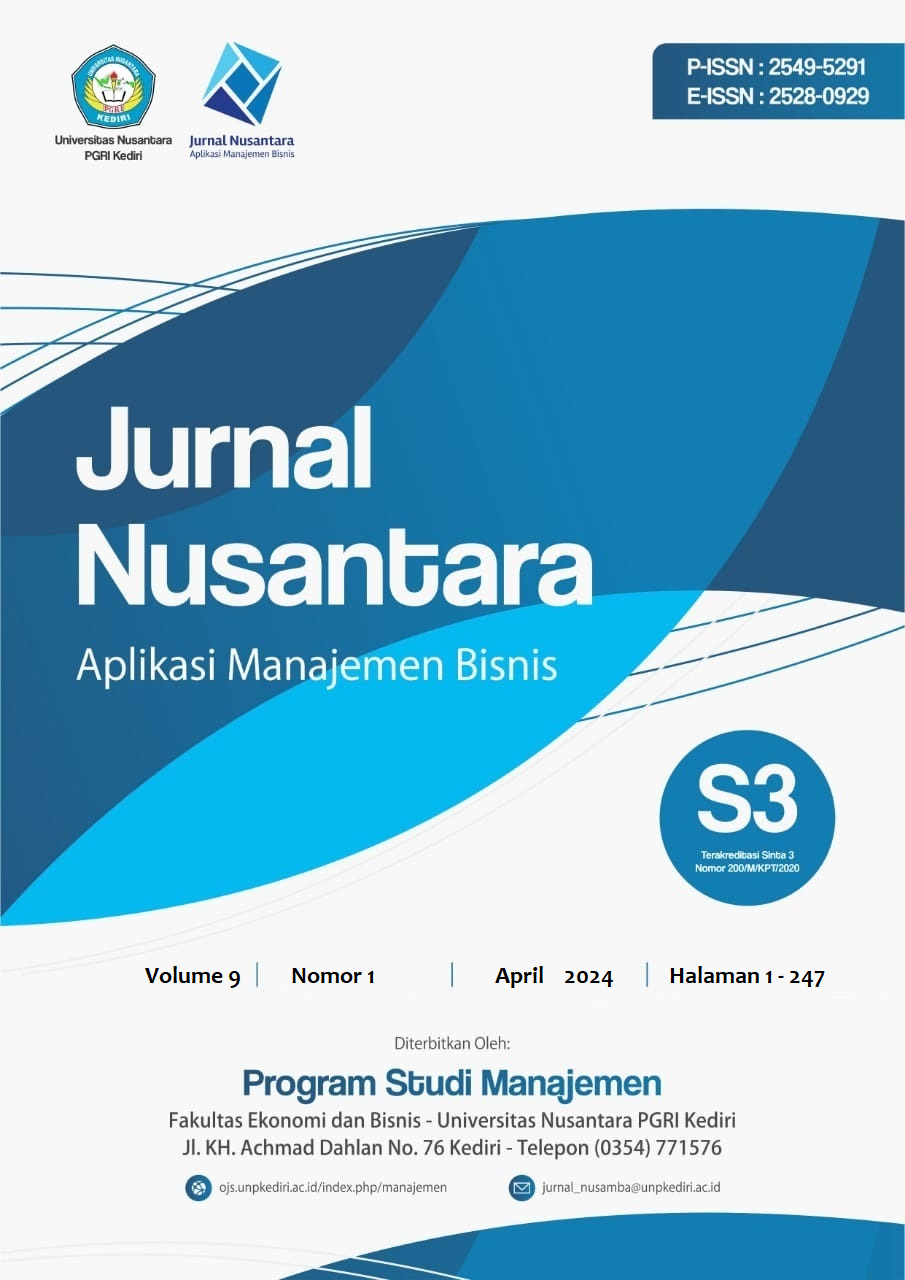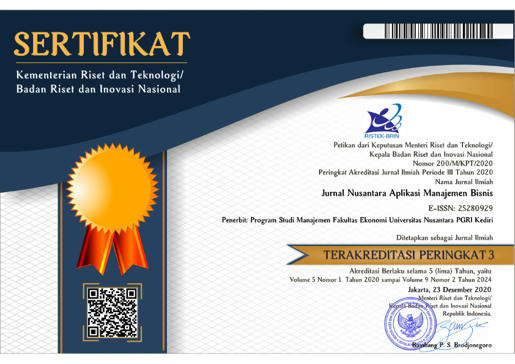Kapabilitas Dinamis Sebagai Penentu Dalam Mengadopsi Penerapan Bisnis Berbasis Teknologi Digital
DOI:
https://doi.org/10.29407/nusamba.v9i1.18563Keywords:
Dynamic capabilities, MSMEs, digital technology, resources, SEM-PLSAbstract
Research aim: This research aims to analyze the influence of dynamic capabilities on the adoption of technology-based digital business applications in Small and Medium Enterprises (SMEs).
Method: The study collected primary data through field studies in North Kalimantan, involving 73 SMEs using digital platforms, and analyzed it using Partial Least Squares - Structural Equation Modeling (PLS-SEM).
Finding: Sensing, learning, and integrating capabilities positively impact the use of digital business tools, while coordinating capability doesn't seem to have a significant effect. Sensing involves watching market changes, leading to more digital marketing and customer reach. Learning drives gathering and using information for product improvement, increasing digital tool usage. Integrating fosters teamwork, aiding in digital tool adoption for better coordination. However, coordinating capability doesn't heavily affect digital tool usage, possibly due to SMEs' smaller scale.
Theoretical contribution/Originality: This study supports the Resource-Based View (RBV) theory, emphasizing that dynamic capabilities help firms adjust resources to changing business landscapes, highlighting the significance of sensing, learning, and integrating capabilities for SMEs to effectively adopt technology-based digital business applications.
Practitioner/Policy implication: SMEs intending to embrace digital business strategies should focus on enhancing dynamic capabilities, especially in sensing, learning, and integrating, to minimize conflicts and failures in technology adoption and ensure adaptability in dynamic business settings.
Research limitation: The study encountered sample size limitations because of SMEs' hesitance to participate, potentially worsened by post-pandemic recovery activities.
Downloads
References
Santiago, O. Caballero, and Morales, "Innovation as recovery strategy for SMEs in emerging economies during the COVID-19 pandemic," Research in International Business and Finance vol. 57, 2021.
I. J. Akpan, E. A. P. Udoh, and B. Adebisi, "Small business awareness and adoption of state-of-the-art technologies in emerging and developing markets, and lessons from the COVID-19 pandemic," Journal of Small Business & Entrepreneurship, pp. 1-18, 2020.
P. Soto-Acosta, "COVID-19 Pandemic: Shifting Digital Transformation to a High-Speed Gear," Information Systems Management, vol. 37, no. 4, pp. 260-266, 2020.
(2020). Dirjen PPI: Survei Penetrasi Pengguna Internet di Indonesia Bagian Penting dari Transformasi Digital.
APJII, "Laporan Survei Internet APJII 2019 – 2020 (Q2)," Asosiasi Penyelenggara Jasa Internet Indonesia, Jakarta2020.
T. Papadopoulos, K. N. Baltas, and M. E. Balta, "The use of digital technologies by small and medium enterprises during COVID-19: Implications for theory and practice," International Journal of Information Management, vol. 55, 2020.
D. Teece and G. Pisano, "The Dynamic Capabilities of Firms: An Introduction," Industrial and Corporate Change, vol. 3, no. 3, pp. 537-556, 1994.
D. J. Teece, G. Pisano, and A. Shuen, "Dynamic Capabilities and Strategic Management," Strategic Management Journal, vol. 18, no. 7, pp. 509-533, 1997.
J. B. Barney, "Strategic factor markets: Expectations, luck, and business strategy," Management Science, vol. 32, no. 10, pp. 1231-1242, 1986.
A. Yeow, ChristinaSoh, and RinaHansen, "Aligning with new digital strategy: A dynamic capabilities approach," The Journal of Strategic Information Systems, vol. 27, no. 1, pp. 43-58, 2018.
C. E. Helfat and J. A. Martin, "Dynamic Managerial Capabilities: Review and Assessment of Managerial Impact on Strategic Change," Journal of Management, vol. 41, no. 5, pp. 1281-1312, 2015.
K. S.R.Warnera and M. Wäger, "Building dynamic capabilities for digital transformation: An ongoing process of strategic renewal," Long Range Planning, vol. 52, no. 3, pp. 326-349, 2019.
S.-M. Tseng and P.-S. Lee, "The effect of knowledge management capability and dynamic capability on organizational performance," Journal of Enterprise Information Management, vol. 27, no. 2, pp. 158-179, 2014.
M. Eikelenboom and G. d. Jong, "The impact of dynamic capabilities on the sustainability performance of SMEs," Journal of Cleaner Production vol. 235 pp. 1360-1370, 2019.
A. Pezeshkana, S. Fainshmidtb, A. Nairc, M. L. Frazierd, and E. Markowskie, "An empirical assessment of the dynamic capabilities–performance relationship," Journal of Business Research, vol. 69, no. 8, pp. 2950-2956, 2016.
R. Cannas, "Exploring digital transformation and dynamic capabilities in agrifood SMEs," Journal of Small Business Management, pp. 1-27, 2021.
S. Garbellano and M. d. R. D. Veiga, "Dynamic capabilities in Italian leading SMEs adopting industry 4.0," Measuring Business Excellence, vol. 23, no. 4, pp. 472-483, 2019.
R. Hernández-Linares, F. W. Kellermanns, and M. C. López-Fernández, "Dynamic capabilities and SME performance: The moderating effect of market orientation," Journal of Small Business Management, 2020.
E. M. Olson, K. M. Olson, A. J. Czaplewski, and T. M. Key, "Business strategy and the management of digital marketing," Business Horizons, vol. 64, no. 2, pp. 285-293, 2021.
I. Trinugroho, P. Pamungkas, J. Wiwoho, S. M. Damayanti, and T. Pramono, "Adoption of Digital Technologies for Micro and Small Business in Indonesia," Finance Research Letters, p. 102156, 2021.
M. Sholihin and D. Ratmono, Analisis SEM-PLS dengan Warp PLS 3.0 untuk Hubungan Nonlinier dalam Penelitian Sosial dan Bisnis. Yogyakarta: Penerbit ANDI, 2013.
H. Latan and I. Ghozali, Partial Least Square Konsep, Metode dan Aplikasi Menggunakan WarpPLS 5.0. Semarang: Badan Penerbit Universitas Diponegoro, 2016.
A. Schwarz, M. Kalika, H. Kefi, and C. Schwarz, "A Dynamic Capabilities Approach to Understanding the Impact of IT-Enabled Businesses Processes and IT-Business Alignment on the Strategic and Operational Performance of the Firm,," Communications of the Association for Information Systems:, vol. 26, no. Article 4, pp. 57-84, 2010.
P. M. Madhani, "Resource Based View (RBV) of Competitive Advantages: Importance, Issues and Implications," KHOJ Journal of Indian Management Research and Practices,, vol. 1, no. 2, pp. 2-12, 2009.
Downloads
Published
Issue
Section
License
Authors who publish with this journal agree to the following terms:
- Copyright on any article is retained by the author(s).
- The author grants the journal, the right of first publication with the work simultaneously licensed under a Creative Commons Attribution License that allows others to share the work with an acknowledgment of the work’s authorship and initial publication in this journal.
- Authors are able to enter into separate, additional contractual arrangements for the non-exclusive distribution of the journal’s published version of the work (e.g., post it to an institutional repository or publish it in a book), with an acknowledgment of its initial publication in this journal.
- Authors are permitted and encouraged to post their work online (e.g., in institutional repositories or on their website) prior to and during the submission process, as it can lead to productive exchanges, as well as earlier and greater citation of published work.
- The article and any associated published material is distributed under the Creative Commons Attribution-ShareAlike 4.0 International License












